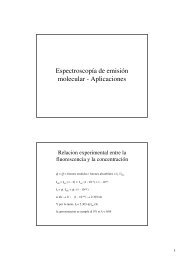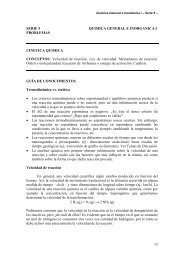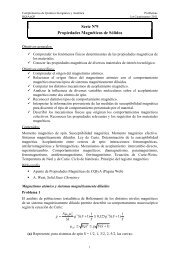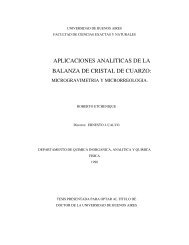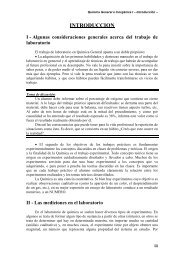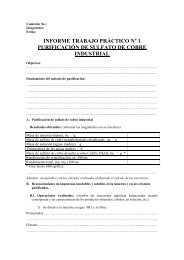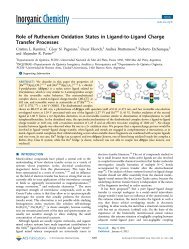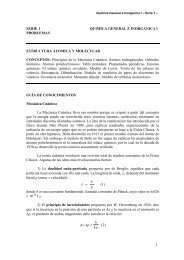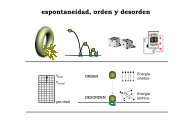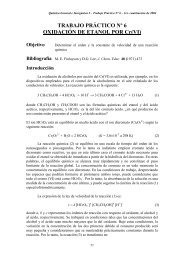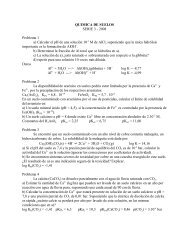The Particle in a Box [and in a Circular Box]
The Particle in a Box [and in a Circular Box]
The Particle in a Box [and in a Circular Box]
You also want an ePaper? Increase the reach of your titles
YUMPU automatically turns print PDFs into web optimized ePapers that Google loves.
Department of Chemistry<br />
Chemistry Education Materials<br />
University of Connecticut Year 2006<br />
<strong>The</strong> <strong>Particle</strong> <strong>in</strong> a <strong>Box</strong> (<strong>and</strong> <strong>in</strong> a <strong>Circular</strong><br />
<strong>Box</strong>)<br />
Carl W. David<br />
University of Connecticut, Carl.David@uconn.edu<br />
This paper is posted at DigitalCommons@UConn.<br />
http://digitalcommons.uconn.edu/chem educ/12
<strong>The</strong> <strong>Particle</strong> <strong>in</strong> a <strong>Box</strong> (<strong>and</strong> <strong>in</strong> a <strong>Circular</strong> <strong>Box</strong>)<br />
C. W. David<br />
Department of Chemistry<br />
University of Connecticut<br />
Storrs, Connecticut 06269-3060<br />
(Dated: June 27, 2006)<br />
<strong>and</strong>, tak<strong>in</strong>g the second derivative, we have<br />
I. SYNOPSIS<br />
where A, B, <strong>and</strong> ω are unknown (to be determ<strong>in</strong>ed) constants.<br />
Tak<strong>in</strong>g the first derivative of this solution, we holds. Formally,<br />
And we can change 1 to 17, <strong>and</strong> 2 to 43, <strong>and</strong> the same<br />
have<br />
∫ L<br />
dψ(x)<br />
dx = −Aω s<strong>in</strong>(ωx) + Bω cos(ωx) ψ n (x)ψ m (x)dx = 0<br />
0<br />
<strong>The</strong> particle <strong>in</strong> a box is the simplest problem <strong>in</strong> elementary<br />
quantum mechanics, <strong>and</strong> as such is useful <strong>in</strong> more<br />
dx 2 = −Aω 2 cos(ωx) − Bω 2 s<strong>in</strong>(ωx)<br />
d 2 ψ(x)<br />
places than one can easily enumerate. For <strong>in</strong>stance, the<br />
molecular orbital theory is expla<strong>in</strong>ed easily <strong>in</strong> terms of<br />
which is, of course,<br />
particle <strong>in</strong> a box wavefunctions, easier than us<strong>in</strong>g st<strong>and</strong>ard<br />
atomic orbitals. Hence, the attention to this particular<br />
−ω 2 ψ(x)<br />
problem.<br />
II. INTRODUCTION<br />
This means that<br />
− ¯h2 (<br />
−ω 2 ψ(x) ) = Eψ(x)<br />
2m<br />
We start with a choice of coord<strong>in</strong>ate systems, which, by<br />
the way, <strong>in</strong>fluences the form of the solutions we are go<strong>in</strong>g<br />
or, said <strong>in</strong> the most straightforward manner, E is related<br />
to ω i.e.,<br />
to get, but not the substance. Here, we choose to use<br />
0
2<br />
if n≠m. Of course, when n=m, we have the normalization<br />
<strong>in</strong>tegral<br />
∫ L<br />
0<br />
ψ 2 n(x)dx ≠ 0<br />
i.e., someth<strong>in</strong>g other than zero. This last condition is<br />
used to choose the (so far) arbitrary constant, A, to force<br />
the <strong>in</strong>tegral to have a value of 1, <strong>in</strong> accord with the probabilistic<br />
<strong>in</strong>terpretation of the wave function. S<strong>in</strong>ce these<br />
are, <strong>in</strong> the case of the particle <strong>in</strong> a box, <strong>in</strong>tegrals of products<br />
of s<strong>in</strong>es, we have<br />
∫ L<br />
0<br />
nπ<br />
eı L<br />
(A x nπ −ı<br />
− e<br />
2ı<br />
L x<br />
) 2<br />
dx<br />
√<br />
2<br />
L<br />
which are trivial. A turns out to be if we force the<br />
<strong>in</strong>tegral to be 1. Aga<strong>in</strong>, this is expla<strong>in</strong>ed <strong>in</strong> every text<br />
book. Of course, the orthogonality <strong>in</strong>tegrals may also be<br />
evaluated us<strong>in</strong>g DeMoivre’s theorem. All of this turns<br />
out to be extraord<strong>in</strong>arily elementary.<br />
III.<br />
A RECTANGULAR BOX<br />
When we talk about rectangular <strong>and</strong> square boxes <strong>in</strong><br />
two dimensional particle <strong>in</strong> a box problems, we are gett<strong>in</strong>g<br />
set up to discuss degeneracy. <strong>The</strong> wave equation<br />
itself offers no h<strong>in</strong>t of the complexity that is com<strong>in</strong>g, but<br />
the boundary conditions, which are <strong>in</strong>extricably bound<br />
to the solutions of the Schröd<strong>in</strong>ger Equation, are the key<br />
here.<br />
Assum<strong>in</strong>g we are work<strong>in</strong>g <strong>in</strong> the x-y space (2 dimensions),<br />
so ψ(x, y) is what is be<strong>in</strong>g sought, we have<br />
(<br />
− ¯h2 ∂ 2 )<br />
ψ<br />
2µ ∂x 2 + ∂2 ψ<br />
∂y 2 = Eψ (3.1)<br />
where x <strong>and</strong> y are the st<strong>and</strong>ard Cartesian coord<strong>in</strong>ates.<br />
<strong>The</strong> solution to this variable separable differential equation<br />
is discussed <strong>in</strong> all texts, <strong>and</strong> has the form<br />
X(x)Y (y) = N lx,l y<br />
s<strong>in</strong> n xπx<br />
l x<br />
s<strong>in</strong> n yπy<br />
l y<br />
where n x <strong>and</strong> n y are <strong>in</strong>teger quantum numbers, rang<strong>in</strong>g<br />
from 1 to ∞. <strong>The</strong> box is rectangular if l x ≠ l y . N lx,l y<br />
is<br />
the normalization factor, which has the form<br />
√ √<br />
2 2<br />
N lx,l y<br />
=<br />
l x<br />
Once substituted <strong>in</strong>to the orig<strong>in</strong>al Schröd<strong>in</strong>ger Equation,<br />
the solution suggests that the energy is given by the<br />
formula:<br />
( (nx<br />
E nx,n y<br />
= ¯h2 π 2 ) 2 ( ) ) 2 ny<br />
+<br />
(3.2)<br />
2µ l x l y<br />
l y<br />
(a well known result).<br />
<strong>The</strong> degeneracy appears when we allow the length of<br />
the two sides of the ”box” to become equal. At that<br />
po<strong>in</strong>t, we can factor the common l = l x = l y out of this<br />
formula to obta<strong>in</strong><br />
E nx,n y<br />
= ¯h2 π 2 (<br />
n<br />
2<br />
2µl 2 x + n 2 )<br />
y<br />
It is clear that the sum of two squares can add up to the<br />
same value, e.g., 5 2 +2 2 = 2 2 +5 2 , i.e., n 2 x+n 2 y = reverse.<br />
We are see<strong>in</strong>g a double degeneracy emerg<strong>in</strong>g. (In three<br />
dimensions, we would have a three fold degeneracy develop<strong>in</strong>g,<br />
when the box became cubical.) Notice that when<br />
n x = n y , we have a loss of degeneracy.<br />
IV.<br />
A CIRCULAR BOX<br />
Squares are nice, but we learn more from circles. Consider<br />
a two dimensional particle <strong>in</strong> a circular box. <strong>The</strong><br />
particle is restricted to be with<strong>in</strong> r=R, where R is a<br />
constant. This is a polar coord<strong>in</strong>ate problem, s<strong>in</strong>ce the<br />
boundary condition will be that ψ(R, θ) = 0∀θ, i.e., the<br />
wave function will be required to vanish at the edge of<br />
the disk region.<br />
<strong>The</strong> first th<strong>in</strong>g we have to do is transform the<br />
Schröd<strong>in</strong>ger Equation from Cartesian to polar coord<strong>in</strong>ates.<br />
We are go<strong>in</strong>g from (x, y) → (r, θ). <strong>The</strong> transformation<br />
equations are<br />
x = r cos θ<br />
y = r s<strong>in</strong> θ (4.1)<br />
which says, given r <strong>and</strong> θ, we can compute x <strong>and</strong> y. <strong>The</strong><br />
reverse equations are<br />
r = √ x 2 + y 2<br />
θ = tan −1 y x<br />
(4.2)<br />
which says the reverse, i.e., given x <strong>and</strong> y, we can compute<br />
r <strong>and</strong> θ.<br />
First we need to express ∂<br />
∂x<br />
is terms of partial derivatives<br />
with respect to r <strong>and</strong> θ. From the cha<strong>in</strong> rule we<br />
have<br />
( ) ( ) ( ) ( ) ( )<br />
∂ ∂r ∂ ∂θ ∂<br />
=<br />
+<br />
∂x<br />
y<br />
∂x<br />
y<br />
∂r<br />
θ<br />
∂x<br />
y<br />
∂θ<br />
r<br />
where we are carefully attempt<strong>in</strong>g to <strong>in</strong>dicate what is<br />
constant dur<strong>in</strong>g each partial differentiation. We f<strong>in</strong>d that<br />
( ) (<br />
∂r ∂ √ )<br />
x<br />
=<br />
2 + y 2<br />
= 1 2x<br />
∂x<br />
y<br />
∂x 2 r = cos θ<br />
<strong>and</strong><br />
( ) ∂θ<br />
=<br />
∂x<br />
y<br />
y<br />
( ∂ tan<br />
−1 y )<br />
∂x<br />
x<br />
y
3<br />
This latter differential is a little more difficult than the<br />
former one was, <strong>and</strong> we attack it <strong>in</strong> a special manner,<br />
guaranteed to br<strong>in</strong>g a smile of recognition to weary readers.<br />
Specifically, we use implicit differentiation. Thus<br />
so<br />
tan θ = y x<br />
which is<br />
d tan θ = dy x − ydx<br />
x 2<br />
= d s<strong>in</strong> θ<br />
cos θ = dθ + s<strong>in</strong>2 θ<br />
cos 2 θ dθ<br />
so, hold<strong>in</strong>g y constant, one has<br />
( ) 1<br />
cos 2 dθ = − ydx<br />
θ x 2 → dθ<br />
dx = −<br />
dy<br />
x − ydx ( )<br />
x 2 = 1 + s<strong>in</strong>2 θ<br />
cos 2 dθ =<br />
θ<br />
(<br />
y<br />
1<br />
cos 2 θ<br />
( cos 2 θ + s<strong>in</strong> 2 θ<br />
cos 2 θ<br />
) ( ) 1<br />
dθ =<br />
cos 2 dθ<br />
θ<br />
( )<br />
) → −y cos2 θ 1<br />
x<br />
2 x 2 cos 2 dθ = − ydx<br />
θ x 2 → dθ<br />
dx = − (<br />
y<br />
1<br />
cos 2 θ<br />
)<br />
x<br />
2 → −y cos2 θ<br />
x 2<br />
so<br />
dθ<br />
dx = −tan θ cos2 θ<br />
K<br />
( ) dθ<br />
= − tan θ cos2 θ<br />
= − s<strong>in</strong> θ<br />
dx<br />
y<br />
r cos θ r<br />
Go<strong>in</strong>g the other way i.e., hold<strong>in</strong>g x constant, we have<br />
dy<br />
x = dθ<br />
cos 2 θ<br />
cos 2 θ<br />
x<br />
=<br />
( ) ∂θ<br />
∂y<br />
x<br />
cos 2 ( )<br />
θ ∂θ<br />
r cos θ = ∂y<br />
x<br />
cos θ<br />
r<br />
=<br />
( ) ∂θ<br />
∂y<br />
x<br />
so<br />
( ) ( )<br />
∂<br />
∂<br />
= cos θ − s<strong>in</strong> θ ( ) ∂<br />
∂x<br />
y<br />
∂r<br />
θ<br />
r ∂θ<br />
r<br />
( ∂<br />
∂y<br />
)<br />
x<br />
( ) ∂<br />
= s<strong>in</strong> θ + cos θ ( ) ∂<br />
∂r<br />
θ<br />
r ∂θ<br />
r<br />
<strong>The</strong> second partial derivatives then must be<br />
( ∂<br />
2<br />
( ∂<br />
2<br />
∂x 2 )y<br />
∂y 2 )x<br />
= ∂ ( cos θ ( )<br />
∂<br />
∂r θ − ( s<strong>in</strong> θ ∂<br />
) )<br />
r ∂θ r<br />
∂x<br />
= ∂ ( s<strong>in</strong> θ ( )<br />
∂<br />
∂r θ + ∂ ( cos θ ∂<br />
) )<br />
r ∂θ r<br />
∂y<br />
Equation 4.3 exp<strong>and</strong>s to become<br />
(4.3)<br />
(4.4)<br />
( ∂<br />
2<br />
∂x 2 )y<br />
= cos θ<br />
(<br />
∂<br />
(<br />
cos θ<br />
( ∂<br />
∂r<br />
)<br />
− s<strong>in</strong> θ<br />
θ r<br />
∂r<br />
( ∂<br />
) ))<br />
∂θ<br />
r<br />
− s<strong>in</strong> θ<br />
r<br />
(<br />
∂<br />
(<br />
cos θ<br />
( ∂<br />
∂r<br />
)<br />
− s<strong>in</strong> θ<br />
θ r<br />
∂θ<br />
( ∂<br />
) ))<br />
∂θ<br />
r<br />
i.e.,<br />
( ∂<br />
2<br />
∂x 2 )y<br />
+ s<strong>in</strong>2 θ<br />
r<br />
= cos 2 θ ∂2 s<strong>in</strong> θ cos θ<br />
+<br />
∂r2 r 2<br />
∂ s<strong>in</strong> θ cos θ<br />
−<br />
∂r r<br />
∂ 2 s<strong>in</strong> θ cos θ<br />
+<br />
∂r∂θ r 2<br />
∂ s<strong>in</strong> θ cos θ<br />
−<br />
∂θ r<br />
∂ 2<br />
∂r∂θ<br />
∂<br />
∂θ + s<strong>in</strong>2 θ<br />
r 2 ∂ 2<br />
∂θ 2 (4.5)
4<br />
For the y term we have<br />
( ∂<br />
2<br />
∂y 2 )x<br />
= s<strong>in</strong> θ<br />
( (<br />
∂ s<strong>in</strong> θ<br />
∂<br />
∂r + cos θ<br />
r<br />
∂r<br />
∂<br />
∂θ<br />
))<br />
+ cos θ<br />
r<br />
( (<br />
∂ s<strong>in</strong> θ<br />
∂<br />
∂r + cos θ<br />
r<br />
∂θ<br />
∂<br />
∂θ<br />
))<br />
(4.6)<br />
i.e.,<br />
( ∂<br />
2<br />
+ cos2 θ<br />
r<br />
∂y 2 )x<br />
so, add<strong>in</strong>g the two relevant results we have<br />
( ∂<br />
2<br />
∂y 2 )x<br />
+ s<strong>in</strong>2 θ<br />
r<br />
+ cos2 θ<br />
r<br />
= s<strong>in</strong> 2 θ ∂2 cos θ s<strong>in</strong> θ<br />
−<br />
∂r2 r 2<br />
∂ cos θ s<strong>in</strong> θ<br />
+<br />
∂r r<br />
( ∂<br />
2<br />
+<br />
∂x<br />
)y<br />
2<br />
∂ 2 cos θ s<strong>in</strong> θ<br />
−<br />
∂r∂θ r 2<br />
∂ s<strong>in</strong> θ cos θ<br />
+<br />
∂θ r<br />
∂ 2<br />
∂r∂θ<br />
{ }} {<br />
= ∂2 s<strong>in</strong> θ cos θ ∂ s<strong>in</strong> θ cos θ ∂ 2<br />
+<br />
∂r2 }<br />
r 2 −<br />
{{<br />
∂θ<br />
}<br />
r ∂θ∂r<br />
{ }} {<br />
∂<br />
∂r − s<strong>in</strong> θ cos θ ∂ 2 s<strong>in</strong> θ cos θ ∂<br />
+<br />
r ∂r∂θ r 2 + s<strong>in</strong>2 θ ∂ 2<br />
} {{<br />
∂θ<br />
}<br />
r 2 ∂θ 2<br />
{ }} {<br />
cos θ s<strong>in</strong> θ ∂ s<strong>in</strong> θ cos θ ∂ 2<br />
−<br />
}<br />
r 2 +<br />
{{<br />
∂θ<br />
}<br />
r ∂r∂θ<br />
{ }} {<br />
∂<br />
∂r + cos θ s<strong>in</strong> θ ∂ 2 cos θ s<strong>in</strong> θ ∂<br />
−<br />
r ∂r∂θ<br />
}<br />
r 2<br />
{{<br />
∂θ<br />
}<br />
∂<br />
∂θ + cos2 θ ∂ 2<br />
r 2 ∂θ 2 (4.7)<br />
+ cos2 θ<br />
r 2 ∂ 2<br />
∂θ 2 (4.8)<br />
which becomes<br />
∂ 2<br />
∂r 2 + 1 ∂<br />
r ∂r + 1 ∂ 2<br />
r 2 ∂θ 2<br />
V. NOW, THE QUANTUM MECHANICS<br />
<strong>The</strong> Schröd<strong>in</strong>ger Equation now becomes<br />
(<br />
− ¯h2 ∂ 2 ψ<br />
2m ∂r 2 + 1 ∂ψ<br />
r ∂r + 1 ∂ 2 )<br />
ψ<br />
r 2 ∂θ 2 + zero × ψ = Eψ<br />
(why zero because a particle <strong>in</strong> a box just feels its<br />
boundaries, i.e., the model is of a particle free to roam<br />
(l<strong>in</strong>early) until it hits a wall.) which is go<strong>in</strong>g to be related<br />
to Bessel’s equation. We know this equation is variable<br />
separable, between r <strong>and</strong> θ, so we will write the solution<br />
as<br />
ψ = R ml (r)e ±mellθ<br />
which, when we substitute this <strong>in</strong>to the Schröd<strong>in</strong>ger<br />
Equation, gives us<br />
(<br />
− ¯h2 ∂ 2 R ml (r)<br />
2m ∂r 2 + 1 )<br />
∂R ml (r)<br />
− m2 l<br />
r ∂r r 2 R m l<br />
(r) = ER ml (r)<br />
which is<br />
r 2 R ′′ (r) + rR ′ (r) + (ɛr 2 − 2m<br />
¯h 2 m2 l)R(r) = 0<br />
where ɛ = 2mE/¯h 2 .<br />
This is one of the forms of the Bessel differential equation.<br />
To br<strong>in</strong>g it to st<strong>and</strong>ard form, we change variables<br />
from r to kρ = r, so<br />
so, choos<strong>in</strong>g<br />
we have<br />
<strong>and</strong> we have<br />
∂ρ<br />
∂r<br />
∂<br />
∂ρ = ∂ ∂r = 1 k<br />
k 2 ɛ = 1<br />
√<br />
1<br />
k =<br />
ɛ<br />
∂<br />
∂ρ<br />
ρ 2 R ′′ (ρ) + ρR ′ (ρ) ′ + (ρ 2 − m 2 l)R(ρ) = 0<br />
It is traditional to solve this equation separately for<br />
different values or m, <strong>and</strong> <strong>in</strong> fact, it is rare to see solutions<br />
for m l > 0 anywhere, s<strong>in</strong>ce the problem, from the po<strong>in</strong>t<br />
of view of quantum mechanics, is quote silly.<br />
For m l = 0 we have<br />
ρ 2 R ′′ (ρ) + ρR ′ (ρ) ′ + ρ 2 R(ρ) = 0<br />
<strong>and</strong> we start the solution by assum<strong>in</strong>g an Ansatz<br />
R(ρ) = ∑ a i ρ i<br />
i=0
5<br />
leav<strong>in</strong>g the question of the <strong>in</strong>dicial equation to more advanced<br />
study. We then have<br />
so<br />
R ′ (ρ) = ∑ i=1<br />
ia i ρ i−1<br />
<strong>and</strong><br />
R ′′ (ρ) = ∑ i=2<br />
(i)(i − 1)a i ρ i−2<br />
ρ 2 R ′′ (ρ) → ∑ − 1)a i ρ<br />
i=2(i)(i i → 2a 2 ρ 2 + (3)(2)a 3 ρ 3 + (4)(3)a 4 ρ 4 + · · ·<br />
+ρR ′ (ρ) ′ → ∑ ia i ρ i → a 1 ρ + 2a 2 ρ 2 + 3a 3 ρ 3 + · · ·<br />
i=1<br />
+(ρ 2 )R(ρ) → ∑ a i ρ i+2 → a 0 ρ 2 + a 1 ρ 3 + a 2 ρ 4 + · · ·<br />
i=0<br />
= 0<br />
Gather<strong>in</strong>g terms <strong>in</strong> the st<strong>and</strong>ard manner, we have<br />
a 2 = −a 0 /2<br />
((3)(2) + 3)a 3 = a 1<br />
a 0 /2<br />
((4)(3) + 4)a 4 = −a 2 =<br />
((4)(3) + 4)<br />
It is fairly obvious that, contrary to other Frobenius<br />
Schemes <strong>in</strong> st<strong>and</strong>ard Quantum Chemistry, this one does<br />
not lead to quantization through truncation of a power<br />
series <strong>in</strong>to a polynomial.<br />
Instead, this Bessel Function’s expansion never term<strong>in</strong>ates,<br />
is never truncated, i.e., rema<strong>in</strong>s an <strong>in</strong>f<strong>in</strong>ite power<br />
series.<br />
<strong>The</strong> quantization occurs when the boundary condition<br />
that the wave function vanish when we are at the rim of<br />
the enclosure is <strong>in</strong>voked.<br />
<strong>The</strong> requirement that the function be zero at the<br />
boundary (r=R), results <strong>in</strong> requir<strong>in</strong>g that the Bessel<br />
function have a zero, call it ρ 0 . This can be found <strong>in</strong><br />
tables of the Bessel Function.A For <strong>in</strong>stance, the first<br />
root, J 0 (ρ 0 ) occurs at ρ 0 = 2.4048 (<strong>and</strong> 5.5207, 8.6537,<br />
11.7915, etc., E. Kreyszig, ”Advanced Eng<strong>in</strong>eer<strong>in</strong>g Mathematics”,<br />
John Wiley <strong>and</strong> Sons. New York, 1962, page<br />
548). So<br />
i.e.,<br />
or,<br />
ρ 0 = R k =<br />
R √<br />
1<br />
ɛ<br />
( ρ0<br />
) 2 2mE<br />
= ɛ =<br />
R<br />
¯h 2<br />
(<br />
E 0 = ¯h2 ρ0<br />
) ( ) 2 2<br />
E0 = ¯h2 2.4048<br />
2m R 2m R<br />
where you have specified the value of R when sett<strong>in</strong>g up<br />
the problem.<br />
<strong>The</strong> zero’s of the Bessel function act to quantize the<br />
energy via the boundary conditions, <strong>in</strong> a slightly different<br />
mode than what we are used to, but never the less,<br />
we obta<strong>in</strong> a result which is quite comfortable <strong>in</strong>side the<br />
context of st<strong>and</strong>ard quantum mechanical constructs.


![The Particle in a Box [and in a Circular Box]](https://img.yumpu.com/36823581/1/500x640/the-particle-in-a-box-and-in-a-circular-box.jpg)
